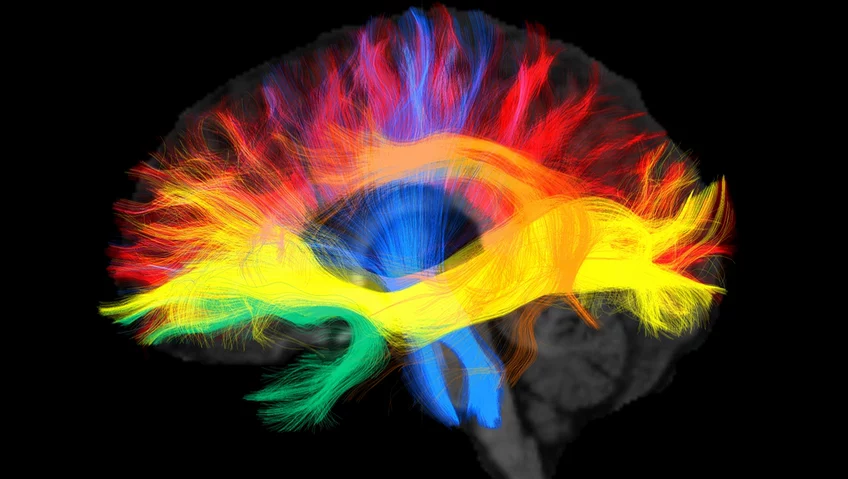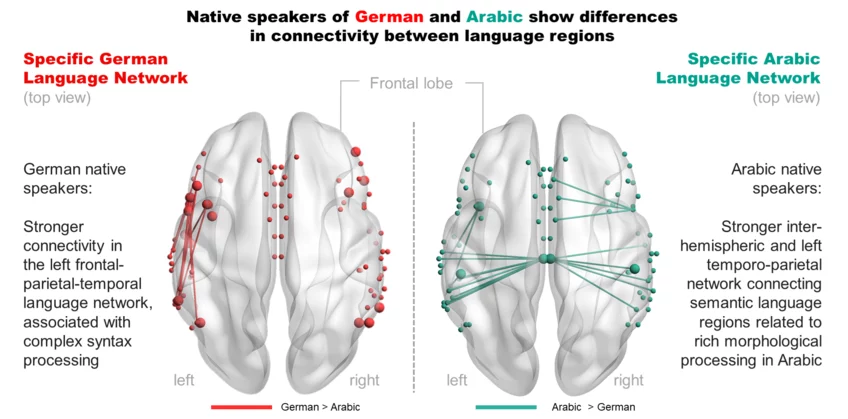نصفي أدمغة الناطقين بالفصحى (كلغة أم) أكثر ارتباطا ببعضهما بالمقارنة مع الناطقين بلغات أخرى
أثبت معهد ماكس بلانك الألماني في دراسة بأن أدمغة العرب تختلف عن أدمغة الناطقين بلغات أخرى ، إذ يظهر بالدليل الملموس أن الارتباط بين نصفي المخ الأيمن والأيسر يكون أقوى لدى الناطقين بالعربية الفصحى (كلغة أم) مقارنة مع المتحدثين بالألمانية . يقول الباحث ألفريد أنواندر المشارك في الدراسة: ” لقد فاجأتنا النتيجة كثيرا، لأننا كنا نفترض دائما أن طريقة تعامل المخ مع اللغات بصفة عامة تسير بطريقة واحدة حول العالم بين المتحدثين باللغات الأم المختلفة مع اختلاف هذه اللغات وبصرف النظر عن طبيعتها”.
فحص فريق البحث المادة البيضاء لأدمغة 94 عربيًا وألمانيًا يتحدثون لغتهم الأم فقط مع بعض الكلمات الإنجليزية . وجدت الدراسة اختلافات في التوصيلات بين مناطق اللغة في نصفي الدماغ حسب اللغة الأم للشخص . التفسير العلمي للاختلاف يعود إلى أن المتحدث باللغة العربية يحتاج إلى الإنصات والتركيز بين المتحدث والمستمع ، فبعض الكلمات يبدو وقعها الموسيقي متشابها على الأذن الأجنبية على سبيل المثال الجذر اللغوي ( ك – ت – ب ) يولد العديد من الكلمات المتشابهة مع تشكيل مختلف لكل منها ويؤثر هذا في بنية المنطقة الدماغية المسؤولة عن معالجة النطق .
فريق البحث بدأ في توسيع الدراسة على لغات أخرى ، ويأمل في إجراء دراسة موسعة حول المتحدثين بالعربية والتغيرات التي ستطرأ على أدمغتهم أثناء تعلمهم الألمانية ، وستقدم هذه الأبحاث استراتيجية مختلفة لتعلم الألمانية بسهولة أكبر.
يقول الباحث ألفريد أنواندر: “من المهم التأكيد على أن هذه الدوائر العصبية المختلفة لمعالجة اللغة في المخ لا تعني مزايا ولا عيوبا للمتحدثين بلغات معينة ، إنما هذه الدوائر العصبية مختلفة فقط في شكل الارتباط فيما بينها ، فهي ليست أفضل في لغة أو أسوأ في لغة أخرى”.
عن موقع قناة الجزيرة على فيس بوك أدناه:
رابط المقال على موقع الجزيرة على فيس بوك
https://www.facebook.com/aljazeerachannel/videos/1154932535185119/
المقال الأصل بالانكليزية من موقع معهد ماكس بلانك الذي أجرى الدراسة
https://www.mpg.de/20008844/our-native-language-shapes-the-brain-wiring
Native language shapes brain wiring
Connections of the language network adapt to the processing demands and difficulties of the mother tongue
MARCH 16, 2023
Brain Language
Scientists at the Max Planck Institute for Human Cognitive and Brain Sciences in Leipzig have found evidence that the language we speak shapes the connectivity in our brains that may underlie the way we think. With the help of magnetic resonance tomography, they looked deep into the brains of native German and Arabic speakers and discovered differences in the wiring of the language regions in the brain.

The scientists analyzed the structural language connectome of native German and Arabic speakers.
© MPI CBS
Xuehu Wei, who is a doctoral student in the research team around Alfred Anwander and Angela Friederici, compared the brain scans of 94 native speakers of two very different languages and showed that the language we grow up with modulates the wiring in the brain. Two groups of native speakers of German and Arabic respectively were scanned in a magnetic resonance imaging (MRI) machine. The high-resolution images not only show the anatomy of the brain, but also allow to derive the connectivity between the brain areas using a technique called diffusion-weighted imaging. The data showed that the axonal white matter connections of the language network adapt to the processing demands and difficulties of the mother tongue.
“Arabic native speakers showed a stronger connectivity between the left and right hemispheres than German native speakers.”, explained Alfred Anwander, last author of the study that was recently published in the journal NeuroImage. “This strengthening was also found between semantic language regions and may be related to the relatively complex semantic and phonological processing in Arabic.” As the researchers discovered, native German speakers showed stronger connectivity in the left hemisphere language network. They argue that their findings may be related to the complex syntactic processing of German, which is due to the free word order and greater dependency distance of sentence elements.

Map of enhanced wiring in the brain of German and Arabic native speakers.
© MPI CBS
“Brain connectivity is modulated by learning and the environment during childhood, which influences processing and cognitive reasoning in the adult brain. Our study provides new insights how the brain adapts to cognitive demands, that is, the structural language connectome is shaped by the mother tongue”, summarizes Anwander. This is one of the first studies to document differences between the brains of people who grew up with different native languages and could give researchers a way to understand cross-cultural processing differences in the brain.
In a next study, the research team will analyze longitudinal structural changes in the brains of Arabic-speaking adults as they learn German over six months.




